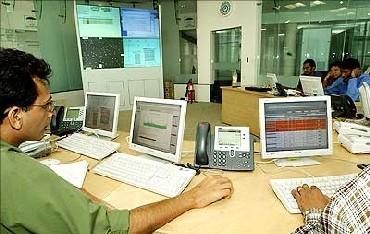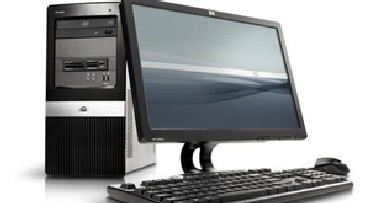
Amit Sawant, a 28-year-old engineering student from Belgaum, recently bought a desktop. It was not a branded one. He had it assembled by a local dealer.
"I am an avid gamer and the graphic cards that are typically bundled with a branded personal computer (PC) are not suitable for high-end games. Those that offer these high-end graphic cards are too expensive. Besides, in a branded PC, if I change or upgrade the components---the processor or the motherboard - I lose the warranty. Hence, I prefer assembled PCs over branded ones," he says. This is the second time he has bought an assembled desktop.
There are hundreds of buyers in India who feel the same. While tablet computers, ultra lightweight notebooks, netbooks and smartphones primarily capture the imagination of urban India, desktops continue to grow, albeit much slower compared to mobile form factors.
...

The growth in the desktop market is driven by the assembled desktop market and sales of desktops to the government and small- and medium-sized enterprises in Tier-II and Tier-III towns.
In the April-June quarter, desktop PCs accounted for 61 per cent of the total market size of 2.5 million PC units sold (the installed base is estimated at around 53 million units), according to Gartner.
CyberMedia Research analysts say desktops comprised 62 per cent of the overall PC shipments in 2010.
...

In 2011, while the growth of desktops is expected to rise 10 per cent to 6.74 million units, the share of desktops as a percentage of total PC shipments is expected to fall marginally to 60 per cent. In 2012, desktops are estimated to grow by 11.9 per cent (7.54 million units).
However, since the growth of portable PCs (notebooks) is around 17 per cent, the share of desktops to the total number of PCs would drop to 59 per cent.
"I do not think the use of desktops would completely diminish. They might remain flat and won't grow at the pace of laptops, but smaller towns, especially C and D towns, are fuelling the growth of desktop PCs. The entire mobility concept is yet to percolate to these regions.
Many enterprises and government departments still prefer desktop PCs, owing to security against data theft. A desktop is also easier to upgrade. There's more space for new PCI cards and IDE disks and faulty accessories and components on a desktop are easy to replace," says Vishal Tripathi, principal research analyst, Gartner.
...

Of the 61 per cent desktop base, almost 51 per cent were white-boxes, that is, personal computers or servers without registered brand names. Nearly 43 per cent of the Indian PC market is accounted for by smaller brands and assembled/unbranded PC manufacturers.
Distributors and channel partners say the pattern of sales of desktops in smaller towns is still governed by the recommendation of local sellers. Distributors also get better margins on white-boxes than on branded PCs, and so, promote them.
The margin on a white-box PC, depending on the configuration, ranges between bight and 10 per cent. Branded PCs offer distributors lower margins.
The sales of Rashi Peripherals, one of the leading distribution companies in India, buttress the desktop growth saga. The firm's peripheral and component business rose 32 per cent last year.
Components grew 10-12 per cent and peripherals rose 30 per cent, while growth for branded desktops was flat.
...

The company expects business to grow 50-55 per cent this year. Managing Director Suresh Pansari says even within the enterprise segment, it is the sales team that prefers laptops.
"The other staff gets desktops. If you look at the national level, we feel the ratio of desktops to laptops is 70:30. In cities, we think desktop would account for 50 per cent of the market share," he says.
Market experts say the difference in the prices of a branded PC and a white-box with the same configuration is almost 20 per cent. New technologies for branded PCs take time in reaching the markets.
"The components take time to reach the assembly plants in India. After this, it takes another month for the product to hit the retail shelves. But components individually hit the retailers or the markets in 15 to 45 days," says a distributor, on the condition of anonymity.
...

The lifetime of desktop spans anywhere from three to five years, while that of mobile products range from six months to two years.
Desktops are also cheaper than laptops, as are add-on products for desktops. Changing or adding features (especially upgrading the processor or the motherboard) in a branded PC is more difficult.
But the PC landscape is rapidly changing. CyberMedia Research analysts expect tablets launched in India in November 2010 to become the new battleground, as major multi-national companies and Indian vendors and operators race to capture a share of the emerging market.
...

In the first five months of launch in India nearly 85,000 units were sold. Notebooks are growing at a faster pace than desktops. Around 12 million smartphones are expected to be sold in 2011.
The total mobile subscriber base as of July 31 was 858.37 million, of which the active user base was 601.73 million.
What do these numbers imply? "The installed base of mobile PCs and smartphones last year exceeded that of desktop PCs, which is why people say the world is going mobile," says Peter Sondergaard, senior vice-president and global head (research), Gartner. He, however, says all architectural shifts take time.
...

Indian, global trends different
The global trend is different from that observed in emerging countries like India. Worldwide PC unit growth is set to touch 352 million units in 2011- a 3.8 per cent rise, compared to 2010, according to a recent preliminary forecast by Gartner.
PC shipments are estimated to see better growth by the end 2012, when units are expected to touch 404 million units, a 10.9 per cent rise compared to 2011.
However, the growth estimates for PCs in 2011 and 2012 have been reduced from previous projections (9.3 per cent for 2011 and 12.8 per cent for 2012).
According to Gartner analysts, in the long term, a disturbing factor is Generation Y has an entirely different view of client devices than their previous generations, and is not buying PCs as their first, or necessarily the main, device.